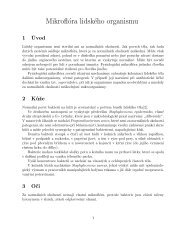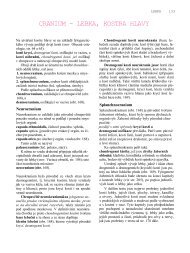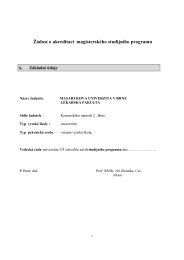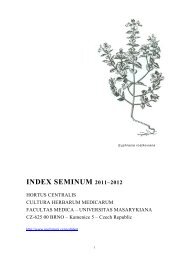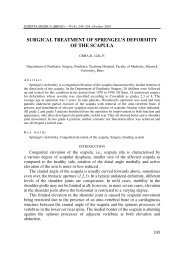Pathophysiology of GIT I
Pathophysiology of GIT I
Pathophysiology of GIT I
Create successful ePaper yourself
Turn your PDF publications into a flip-book with our unique Google optimized e-Paper software.
Complications <strong>of</strong> Crohn’s disease<br />
61<br />
Ulcerative colitis<br />
• max. incidence between 20 – 40.<br />
years <strong>of</strong> age<br />
• typically Caucasian Caucasian race race, north<br />
south gradient<br />
• inflammation limited to mucosa<br />
• starts at the bottom <strong>of</strong><br />
Lieberkuhn’s crypts (infiltration<br />
by immune cells)<br />
• mainly rectum and sigmoideum<br />
• hyperemia hyperemia, abscesses and<br />
ulcerations, bleeding,<br />
pseudopolyps, event. strictures<br />
• clinical course<br />
• periodical = exacerbations x<br />
remissions (diarrhea, bleeding,<br />
abdominal pain, fever)<br />
• extraintestinal t i t ti l manifestations if t ti (5<br />
– 15%): polyarthritis,<br />
osteoporosis, uveitis, cholangitis<br />
• chronic anemia, , strictures, ,<br />
hemorrhoids, carcinoma<br />
63<br />
<strong>Pathophysiology</strong> <strong>of</strong> large intestine<br />
62<br />
• functions<br />
• resorption <strong>of</strong> water (0.5-<br />
1l/24h)<br />
• along the whole length<br />
• motoric<br />
• pathology<br />
• obstipation p<br />
• diverticulosis<br />
• event. divertikulitis<br />
• polyposis l i<br />
• carcinoma<br />
• hereditary<br />
• polyposis<br />
• non-polypose<br />
• non-hereditary<br />
(sporadic)<br />
Polyps <strong>of</strong> large intestine<br />
• polyp = any lesion/prominence<br />
into the lumen<br />
• types<br />
• solitary<br />
• multiple<br />
• familiar polyposis, p yp , FAP) )<br />
• autosomal dominant<br />
• precancerosis, polyps in puberty,<br />
carcinoma after 30th year <strong>of</strong> age<br />
• polyps more common in rectum<br />
but also in ileum<br />
• mutation in APC gene (Wnt<br />
pathway)<br />
• Gardner’s syndrome<br />
• juvenile j ppolyposis yp<br />
• etiology<br />
• hyperplasia in the<br />
inflammatory terrain<br />
• neoplastic<br />
• benign<br />
• malign<br />
64



